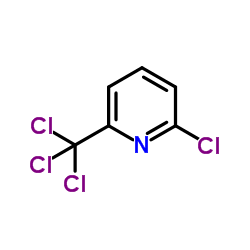Nitrapyrin

Nitrapyrin structure
|
Common Name | Nitrapyrin | ||
|---|---|---|---|---|
| CAS Number | 1929-82-4 | Molecular Weight | 230.907 | |
| Density | 1.6±0.1 g/cm3 | Boiling Point | 258.2±35.0 °C at 760 mmHg | |
| Molecular Formula | C6H3Cl4N | Melting Point | 62-63°C | |
| MSDS | Chinese USA | Flash Point | 134.9±11.5 °C | |
| Symbol |


GHS07, GHS09 |
Signal Word | Warning | |
| Name | nitrapyrin |
|---|---|
| Synonym | More Synonyms |
| Density | 1.6±0.1 g/cm3 |
|---|---|
| Boiling Point | 258.2±35.0 °C at 760 mmHg |
| Melting Point | 62-63°C |
| Molecular Formula | C6H3Cl4N |
| Molecular Weight | 230.907 |
| Flash Point | 134.9±11.5 °C |
| Exact Mass | 228.901962 |
| PSA | 12.89000 |
| LogP | 2.52 |
| Vapour Pressure | 0.0±0.5 mmHg at 25°C |
| Index of Refraction | 1.576 |
| InChIKey | DCUJJWWUNKIJPH-UHFFFAOYSA-N |
| SMILES | Clc1cccc(C(Cl)(Cl)Cl)n1 |
| Storage condition | 0-6°C |
| Water Solubility | Insoluble. |
CHEMICAL IDENTIFICATION
HEALTH HAZARD DATAACUTE TOXICITY DATA
MUTATION DATA
|
| Symbol |


GHS07, GHS09 |
|---|---|
| Signal Word | Warning |
| Hazard Statements | H302-H411 |
| Precautionary Statements | P273 |
| Personal Protective Equipment | dust mask type N95 (US);Eyeshields;Faceshields;Gloves |
| Hazard Codes | Xn:Harmful;N:Dangerousfortheenvironment; |
| Risk Phrases | R22 |
| Safety Phrases | S24-S61 |
| RIDADR | UN 2811 |
| RTECS | US7525000 |
| Packaging Group | III |
| Hazard Class | 6.1(b) |
| HS Code | 2933399053 |
|
~% 
Nitrapyrin CAS#:1929-82-4 |
| Literature: US2010/65416 A1, ; Page/Page column 3; 4; 5 ; |
|
~% 
Nitrapyrin CAS#:1929-82-4 |
| Literature: US2010/65416 A1, ; Page/Page column 5 ; |
|
~% 
Nitrapyrin CAS#:1929-82-4 |
| Literature: Journal of Chemical Thermodynamics, , vol. 21, # 6 p. 615 - 624 |
|
~%
Detail
|
| Literature: US2010/65416 A1, ; Page/Page column 5 ; |
|
~%
Detail
|
| Literature: Journal of Organic Chemistry USSR (English Translation), , vol. 16, # 10 p. 1845 - 1851 Zhurnal Organicheskoi Khimii, , vol. 16, # 10 p. 2163 - 2171 |
|
~64%
Detail
|
| Literature: J. Appl. Chem. USSR (Engl. Transl.), , vol. 56, # 11 p. 2547 - 2550,2362 - 2365 |
| HS Code | 2933399053 |
|---|---|
| Summary | HS:2933399053 2-chloro-6-(trichloromethyl)pyridine VAT:17.0% Tax rebate rate:9.0% Supervision conditions:S MFN tariff:6.5% General tariff:20.0% |
|
Reductive dehalogenation of the trichloromethyl group of nitrapyrin by the ammonia-oxidizing bacterium Nitrosomonas europaea.
Appl. Environ. Microbiol. 59(11) , 3597-601, (1993) Suspensions of Nitrosomonas europaea catalyzed the reductive dehalogenation of the commercial nitrification inhibitor nitrapyrin (2-chloro-6-trichloromethylpyridine). The product of the reaction was i... |
|
|
Selective enhancement of the fluorescent pseudomonad population after amending the recirculating nutrient solution of hydroponically grown plants with a nitrogen stabilizer.
Microb. Ecol. 56(3) , 538-54, (2008) Fluorescent pseudomonads have been associated, via diverse mechanisms, with suppression of root disease caused by numerous fungal and fungal-like pathogens. However, inconsistent performance in diseas... |
|
|
Teratologic evaluation of orally administered nitrapyrin in rats and rabbits.
Fundam. Appl. Toxicol. 11(3) , 464-71, (1988) Pregnant Fischer 344 rats and New Zealand White rabbits were orally administered 0, 5, 15, or 50 mg nitrapyrin/kg/day on Gestation Days 6 through 15 (rats) or 0, 3, 10, or 30 mg/kg/day on Gestation Da... |
| a,a,a,6-Tetrachloro-2-picoline |
| T6NJ BXGGG FG |
| Pyridine, 2-chloro-6-(trichloromethyl)- |
| α,α,α,6-Tetrachloro-2-picoline |
| 2-Chloro-6-trichloromethylpyridine |
| EINECS 217-682-2 |
| MFCD00072500 |
| 2-Chloro-6-(trichloromethyl)pyridine |
| 2-Chloro-6-(trichloromethyl)pyridine,CP |
| Nitrapyrin |







 CAS#:51492-01-4
CAS#:51492-01-4 CAS#:78152-53-1
CAS#:78152-53-1
